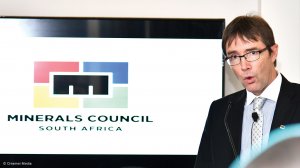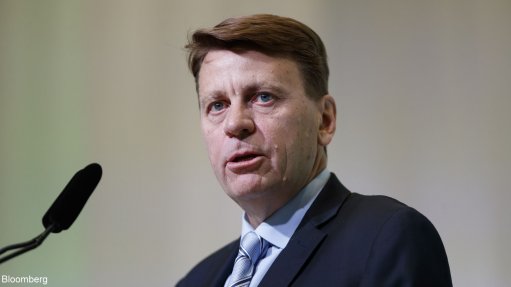Minerals Council says 2018 ‘turning point’ for mining, laments Carbon Tax costs
The mining sector remains an important component of the South African economy, says the Minerals Council South Africa.
The council on Monday published its ‘Facts and Figures 2018’ report, which pointed out that the sector had contributed R350.8-billion to the country’s gross domestic product in 2018, constituting 7.3% of GDP.
Additionally, the Minerals Council said the industry’s fixed investment had increased by 13.2% to R91.1-billion in 2018, which it said had been possible owing to the shifts in South Africa’s and the industry’s political leadership.
Minerals Council CEO Roger Baxter cited 2018 as a “turning point” for South Africa’s mining industry, as well as for the country, adding that the changes in leadership were “necessary in order to deal with the country’s previous downward spiral into recessionary conditions”.
As a result, these changes have introduced a period of new-found business confidence, he noted.
However, the long-term nature of mining means that this increase needs to be sustained for a significant period before it translates to a growing industry.
The report outlines how, since the beginning of this year, the industry has seen significant rises in the prices of commodities that had previously been disappointing for some time.
Although employment in some sectors – such as coal, iron-ore, manganese and chrome – had grown during 2018, this growth was masked by reductions in employment in other sectors – such as gold, diamonds and platinum – which resulted in a net job loss position in the sector during the year.
The industry’s safety performance was more positive with the slight improvement in the number of fatalities in 2018, compared with 2017, largely based on the considerable improvements in the final third of the year.
This improved performance had extended into 2019, the Minerals Council noted.
CARBON TAX
With the mining industry accounting for about 15% of South Africa’s greenhouse-gas (GHG) emissions, the Minerals Council further discusses, among other topics, how it believes the Carbon Tax – which came into effect in June – could cost the industry an additional R900-million to R1.8-billion a year during the first phase of implementation.
The first phase, which runs from June 2019 to December 2022, is considered a transitional period, during which the efficacy of the implementation of the law in the reduction of national GHG emissions will be reviewed. The period will also aim to assist impacted companies with allowances to cushion the impacts of the tax on their operational costs.
In this phase, the carbon tax will be levied on Scope 1 emissions, applying to process and internal combustion emissions. The carbon tax is R120/t of carbon dioxide emitted, which is proposed to increase at a rate of Consumer Price Index plus 2%.
In Phase 1, the National Treasury has proposed several offsets, including but not limited to a 60% basic tax-free allowance, as well as a 10% allowance for process and fugitive emissions and a 5% allowance for companies that have allocated and comply with a carbon budget, as well as a 5% tax-free allowance for above average performance for reducing carbon emissions.
However, given that mining companies face multiple hurdles in starting renewable energy projects, most mining companies have limited scope to get the carbon offset, the Minerals Council noted.
“The uncertainty for the mining sector is compounded by the fact that the Department of Environmental Affairs’ process to finalise carbon offsets and carbon budget regulations is still to be finalised”.
Additionally, in the February 2019 Budget Speech, the National Treasury indicated that during Phase 1, the carbon tax would initially be factored in through a 10c/litre increase in fuel prices.
During the second phase, which will start in January 2021, it is anticipated that the draft Climate Change Bill would have come into law and, as such, it would be compulsory for companies to have a carbon budget.
According to the Minerals Council, however, there is still “considerable uncertainty” around the second phase, particularly, if the tax offsets allowed in Phase 1 will be maintained, and if the electricity generation sector will be allowed to pass on the cost of the tax to consumers.
In the absence of policy certainty from the National Treasury on whether the allowances granted in Phase 1 are to be removed, the council believes the potential carbon tax liability on Scope 1 emissions for the mining sector would rise to R10.2-billion a year.
“Additionally, it is our view, that in Phase 2 of the carbon tax implementation process, the full impact of the carbon tax on electricity will be fed through to the mining sector because the National Treasury has not yet specified any potential tax-free allowances,” the council said.
Overall, the Minerals Council’s analysis found that the imposition of the carbon tax would result in declines of about an additional 6 000 jobs a year, R4-billion in output and R2.2-billion in investment in the mining sector.
The tax would also result in an increase in costs to the tune of R10.2-billion, the council said.
Across the 18 mining companies that responded to a Minerals Council survey in August, the carbon tax is estimated to cost as much as R517-million a year in Phase 1 of the implementation of the tax.
In the absence of the offsets allowed in Phase 1, the carbon tax liability for these 18 companies is estimated to increase to R5.5-billion for each year of Phase 2, which represents a 972% increase in the tax liability, it said.
Comments
Press Office
Announcements
What's On
Subscribe to improve your user experience...
Option 1 (equivalent of R125 a month):
Receive a weekly copy of Creamer Media's Engineering News & Mining Weekly magazine
(print copy for those in South Africa and e-magazine for those outside of South Africa)
Receive daily email newsletters
Access to full search results
Access archive of magazine back copies
Access to Projects in Progress
Access to ONE Research Report of your choice in PDF format
Option 2 (equivalent of R375 a month):
All benefits from Option 1
PLUS
Access to Creamer Media's Research Channel Africa for ALL Research Reports, in PDF format, on various industrial and mining sectors
including Electricity; Water; Energy Transition; Hydrogen; Roads, Rail and Ports; Coal; Gold; Platinum; Battery Metals; etc.
Already a subscriber?
Forgotten your password?
Receive weekly copy of Creamer Media's Engineering News & Mining Weekly magazine (print copy for those in South Africa and e-magazine for those outside of South Africa)
➕
Recieve daily email newsletters
➕
Access to full search results
➕
Access archive of magazine back copies
➕
Access to Projects in Progress
➕
Access to ONE Research Report of your choice in PDF format
RESEARCH CHANNEL AFRICA
R4500 (equivalent of R375 a month)
SUBSCRIBEAll benefits from Option 1
➕
Access to Creamer Media's Research Channel Africa for ALL Research Reports on various industrial and mining sectors, in PDF format, including on:
Electricity
➕
Water
➕
Energy Transition
➕
Hydrogen
➕
Roads, Rail and Ports
➕
Coal
➕
Gold
➕
Platinum
➕
Battery Metals
➕
etc.
Receive all benefits from Option 1 or Option 2 delivered to numerous people at your company
➕
Multiple User names and Passwords for simultaneous log-ins
➕
Intranet integration access to all in your organisation





















